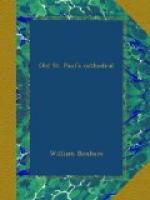* * * * *
CHAPTER IV.
HISTORICAL MEMORIES TO THE ACCESSION OF THE TUDORS.
The First Cathedral—Mellitus and his Troubles—Erkenwald —Theodred “the Good”—William the Norman, his Epitaph —The Second Cathedral—Lanfranc and Anselm hold Councils in it—Bishop Foliot and Dean Diceto—FitzOsbert—King John’s Evil Reign, his Vassalage—Henry III.’s Weak and Mischievous Reign—The Cardinal Legate in St. Paul’s—Bishop Roger “the Black”—The three Edwards, Importance of the Cathedral in their Times—Alderman Sely’s Irregularity—Wyclif at St. Paul’s —Time of the Wars of the Roses—Marriage of Prince Arthur.
I have already said that the buildings of the ancient cathedral, with a special exception to be considered hereafter, were completed before the great ecclesiastical changes of the sixteenth century.
Our next subject will be some history of the events which the cathedral witnessed from time to time during its existence, and for this we have to go back to the very beginning, to the first simple building, whatever it was, in which the first bishop, Mellitus, began his ministry. He founded the church in 604, and he had troubled times. The sons of his patron, King Sebert, relapsed into paganism, indeed they had never forsaken it, though so long as their father lived they had abstained from heathen rites. One day, entering the church, they saw the bishop celebrating the Sacrament, and said, “Give us some of that white bread which you gave our father.” Mellitus replied that they could not receive it before they were baptized; whereupon they furiously exclaimed that he should not stay among them. In terror he fled abroad, as did Justus from Rochester, and as Laurence would have done from Canterbury, had he not received a Divine warning. Kent soon returned to the faith which it had abandoned; but Essex for a while remained heathen, and when Mellitus wished to return they refused him, and he succeeded Laurence at Canterbury. Other bishops ministered to the Christians as well as they could; but the authority of the See and the services of the cathedral were restored by Erkenwald, one of the noblest of English prelates, son of Offa, King of East Anglia. He founded the two great monasteries of Chertsey and Barking, ruled the first himself, and set his sister Ethelburga over the other. In 675 he was taken from his abbey and consecrated fourth Bishop of London by Archbishop Theodore, and held the See until 693. He was a man, by universal consent, of saintly life and vast energy. He left his mark by strengthening the city wall and building the gate, which is called after him Bishopsgate. Close by is the church which bears the name of his sister, St. Ethelburga. He converted King Sebba to the faith; but it was probably




